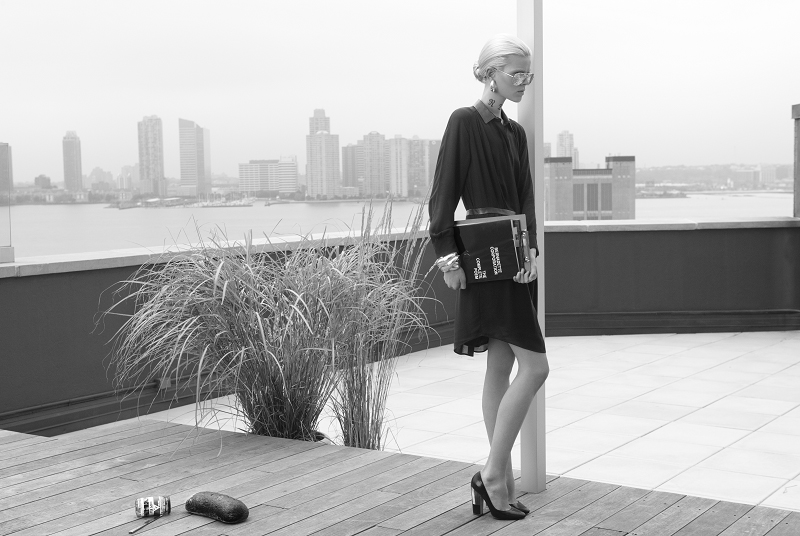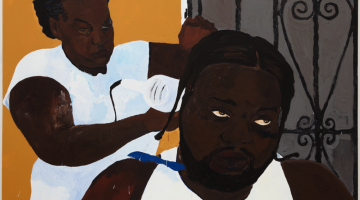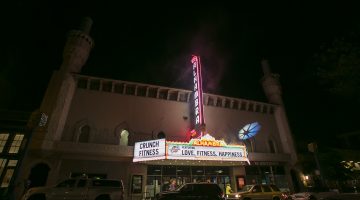Bernadette Corporation: Multiplyplex
Stedelijk Museum
Museumplein 10, 1071 DJ Amsterdam
April 30 – August 28, 2016
At the Stedelijk, a ‘90s TV set mounted to the ceiling plays Fashion Shows, 1995-1997 above a wall-size black-and-white adhesive vinyl BC Lifestyle EXT, 2012. Like the situationists, Bernadette Corporation abhors usable commodity and opts instead for mashing and re-staging the street. Bernadette Corporation starts with the story of a Vietnamese-American Queens native, Brown graduate in Economics, Bernadette Van-Huy. In ‘93 she is offered to host a party at Club USA in NYC. Paid to promote glamour and gentrification, and knowing the power of corporations to “impress people,” Van-Huy, together with Antek Walzcak, a NYU film alum, and artist/critic John Kelsey formed their own, under the moniker Bernadette Corporation.[1] In ‘96, they land some funds from Colin de Land of American Fine Arts Co. and Parisians, Olivier Zham and Elein Fleiss of Purple Magazine.
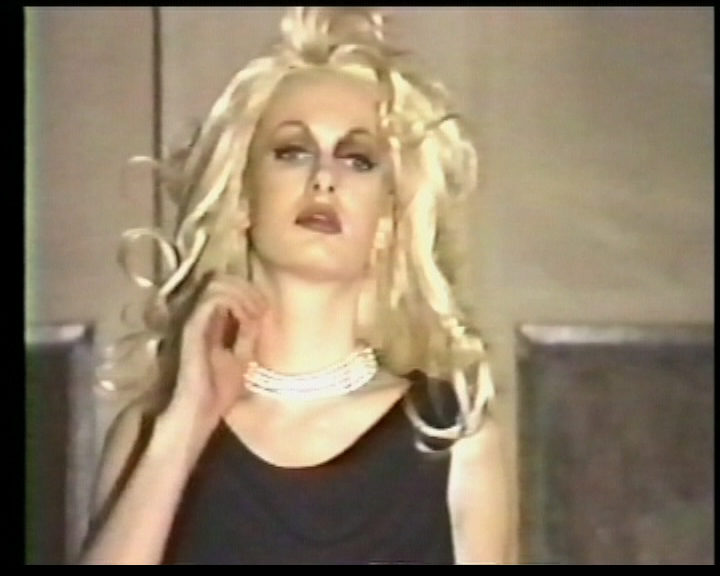
Bernadette Corporation, Fashion Shows, 1995-1997. Collection Stedelijk Museum Amsterdam. Courtesy Stedelijk Museum Amsterdam.
BC’s ‘97 show Streetgangs and Corporations at the Roxy is replete with a sports event, national anthem, half-time show, cheerleaders and bear mascot w/ AK47. Their catwalk collection is often supplemented by Gap, Comme des garcons, Nike, and their work receives attention from Harper’s Bazaar, W, i-D, Visionaire,… As poets of counter culture, the group operates under various guises. Yet, in much of their work, body as material remains centerfold. With Thuy Pham in ’95, they launch a line of women’s fashion, blending haute couture and DIY mimicry to confront tensions between privilege and vulgarity. Their first fashion show is based on Puerto Rican girls of NYC’s lower east side, blackness, sportswear, the slick hair of the masses.
Multipyplex is full of lingering viewers. Vitrines in cross formation center around two barely dressed white mannequins perched on tip-toes atop circular mirrors. One wears a faux-fur grayish jacket from their most excessive FW ’97 collection—Hell on Earth. With a bigger budget—supportedby Casio Csterna, Japan—it is inspired by Michael Jackson, Japanese motorcycles, and goth Latinas. On the back of the jacket, “BC” is framed in gold. The overlapping circles of a Merced-Benz/bio-hazard sign cut-outs expose chipped paint on the mannequin’s back. The other mannequin wears just a chicken bone and chain necklace cum bustier. It resurfaces in a vitrine—adjusted by a man in a cowboy hat and Playboy Tee in a photo of a neck-tattooed blonde model with cornrows and dark lipstick. Atop the glass, another folded paper’s Sharpie words read: ‘“HELL ON EARTH” Fall-winter collection Photos by Cris Moor & Dietmar Busse’.
To introduce their ambulant past, another folded paper has sharpie-scrawled “The BC Corporate Story 1996” atop a black cube-shaped TV. Through white headphones a Southern voice narrates “ …we look for a lot in our models: personality, talent, special skills, versatility and killer looks. Gosh, we love our friends. We love our fans and our friends… we got big plans…” The background song goes on: “…we got a 9 to 5…” The trio appear, one at a time, not long, say nothing. While the worldwide financial crisis led to “unrest and violence,” the BC logo twirls in seriffed, italicized curves. “…When you feel no one wants to know you…you need a hand to brush away the tears…bored of the routine of survival, tired of the weight of alienating conditions…aim to be convincing in a controlled discourse…the grafting of parasitical significations onto anything…”
Inside another display, a body-length closet mirror cracks under the weight of a thick S/S ‘00 MADE IN USA—based on the title of Godard’s “worst/best” film. Their magazine exists in three issues. The first is devoted to spaces, how people can be originals, amateurs or imaginary. The final version includes a text by Silvère Lotringer and Paul Virilio.
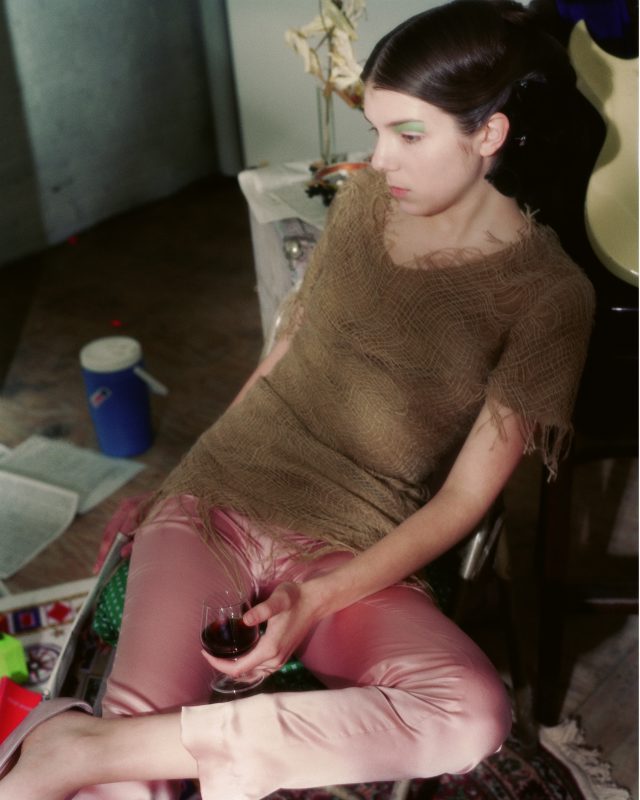
Bernadette Corporation, Untitled Fashion Shoot, 2000. Collection Stedelijk Museum Amsterdam. Courtesy Stedelijk Museum Amsterdam.
The exhibition Let’s Entertain at the Walker Art Center (2000) is based on the idea of a campaign. It consists of a fashion shoot to appear in Made in USA as well as a video shoot. The video for the campaign of Let’s Entertain, titled Hell Frozen Over wafts between shots of models lounging and footage of Lotringer. An Untitled Fashion Shoot, (2000), comes to life in the film, as a model shot from various zooms. She manages to look vacant in all of them, puts herself in the position of an object, wastes time in the frame. Meant to simulate Dutch 16th century paintings these are clichés, easy to watch. Perhaps systematically constructed, they seem improvised. A miniature chair is stuffed into a red suitcase, “the very rich hour” recurs on the screen. Enlarged on the wall, Lotringer narrates, in a cap among the snowy Adirondacks, in front of a frozen lake. With poetics on the color white and Mallarmé, this existential video syncs with BC’s thought, and provides a solid ground to the airiness of fashion prints, slowing the buzz of the museum.
The collective practices, pooled from a vast range of accomplices, allow BC to embed themselves in the broader social, and political world, their group structure indispensable to the actual work they produced. Their freedom seems greater because they can adapt to situations and rely on a network. To re-engineer the dominant models of production and governing forms of exchange, they use an allusion to sell a dream, sell the wrapping…or nothing. As Lotringer explains, some black marks called “words” need to be there so that they can disappear. It is Semiotext(e), Kelsey, Chris Kraus, les presses du réel, that leave the BC’s firmest nachleben.
Pedestrian Cinema (2005-06), an offshoot spurred by meetings with a non-profit in Mexico City and developed in Berlin, consists of posters, short films, and the screenplay Eine Pinot Grigio, Bitte book (Sternberg Press, 2007). Many-hued scripts flop open and re-stage a rehearsal mid-sentence. Grayish poster collages feature a bit of Charlie Chaplin, a kiwi, a model lying in a metallic dress and stilettos, a torn leaf, sausages and potatoes, a carnival tent.
Two projections of Pedestrian Cinema works are separated by a standing wall. Set on framed typewritten index cards, one side hosts a series of texts about zombies, in-flight movies, stealing clean laundry, On the floor, a metallic toilet-paper stand holds three wads, under a fuchsia crisscrossing ticket stub roll.
In true amateur screen-test/trailer-video fashion, Logo Film (1996) keeps the screen occupied by slogan styles and logos more than footage. Two dots plop over an up-spurting fountain, cascade, make it a ghost—then atop it “NO HOPE NO FEAR” in wavy letters. Zoom-in on a mouth doubled, one overlaps the other, grotesquely oozing in watermelon colors. Then: Pedestrian Cinema, another slogan blurred, emerging from the pixels in crisp Times New Roman: “the unholy 3.” A glitchy rainbow makes a grid of lines over a still life including bruised apple.
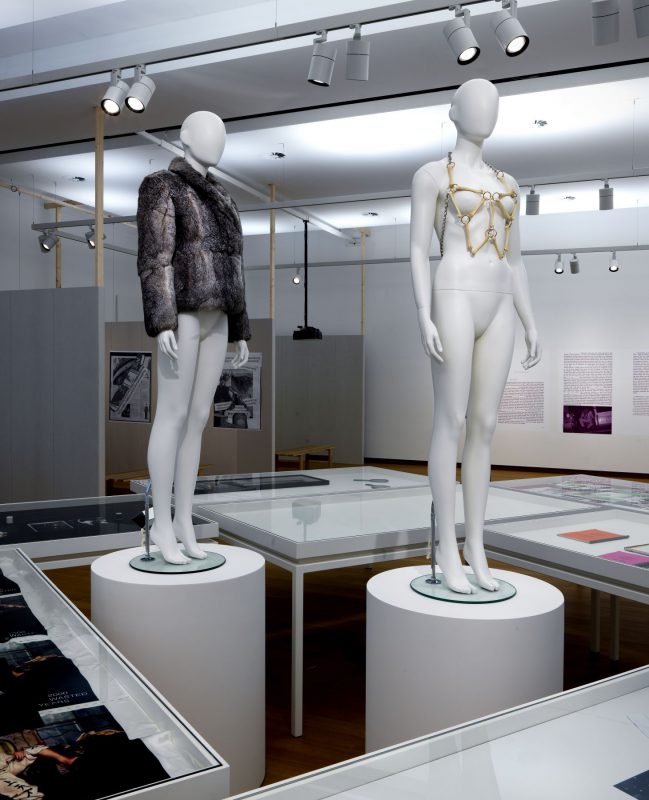
Installation view, Bernadette Corporation: Multiplyplex, Stedelijk Museum, Amsterdam, 2016 Courtesy Green Naftali Gallery.
BC’s continuous attempts to manipulate the lust vomit of fashion as a form of resistance affords a recurring problem… whose network does this warped luxe target? Is embracing chaos volatile or parochial? BC is a multi-pronged avatar to flow in and out of. Spearheading the use of a corporate model that uses the marketing logic to create a brand identity—upheld by many others[2]—BC takes on this structure in the hopes of reclaiming identity. The ‘self’ and identity politics are not staged in order to glorify diversity but rather to foreground their collectivity, molded by surroundings, the intimacy of working together, before being ‘selves’ to be made and consumed. The effacement of identity—proposes something that cannot be sold.
In another table-vitrine, NYC photos of anti-capitalist demonstrations show Walczak and Van-Huy with a slew of arrested bodies by historic landmarks. BC revamps a situationist text about the poverty of students, toting fashion as the child of the powers of market and media: “…their well-behaved and grateful child, and like the submissive child he is overeager to please.”[3] Trapped and alive in a certain intimacy, they sought out another kind of identity, expanding to work with various entertainment groups, rock bands, TV actors, artists, promoting others as much as themselves—talent and street life unrecognized by dominant media. Going back to the streets is messy and offers no clear signal. The manifesto-like poses of BC and their linked production gestures towards the destruction of their present—all that was occurring in New York, and the (in)ability to break it enough. Is the ambition to enter another temporality, a post-capital void, an uncoded “wild”? Their ambition allows nihilism to announce the potential for radical aesthetics, beyond identities or completeness, moving across anonymous moods and abstractions, allowing voids to say less about what they are then about what they resist.
Unscathed in the snares of fashion, they abandon its bonds, slip past art producers locked in a stalemate where the ‘self’ is political, inhabiting group-structure as infectious compression in the leisure of a shared privacy that some would try to destroy. It leaves them with no one to blame—a fiction with many appendages is chosen over reality. Here something cannot be replaced by another part, without losing a part of the whole. Is it their indifference to the split between the real and the copy that keeps us coming back?
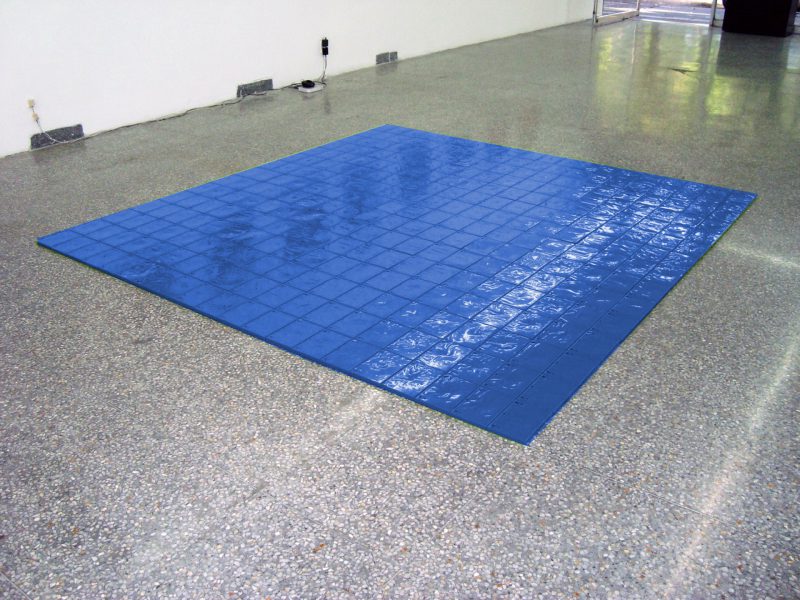
Bernadette Corporation, Quadrato blu-ray HD, 2008. Blu-ray cases acquired in 2015. Collection Stedelijk Museum Amsterdam. Courtesy Stedelijk Museum Amsterdam.
Their Blu-ray sea sprawled on the floor, titled Quatrado Blu-ray HD (2008), is tied to the ethos of pop art. Sites, viewers, too many encounters are held in this abstract panel; the empty clear pockets, limp and expansive cite minimalism, Roni Horn and Felix Gonzales-Torres all at once. It is a pin-up celebrating their year of experimentation with cinematic production. In this time, nothing happens, in this longing for a post-capital where everything goes, as if orbiting out to the extraterrestrial is needed before being able to touch something on earth. They flicker and dissolve: Too fast or too slow? It takes time to absorb those without audience, those without a need for audience.
For BC the budget was not always a barrier. Deviations from the script lure us back into fiction, non-actors always actors, cheap glamour as easy as pretentious documentation. Reality acts as collision. In Multiplyplex, limbs of BC’s corps cannot surpass the gravity of the day but try, more than anything with a certain hope that I can’t explain exactly the excitement of finding.Their works give us a tunnel into a certain kind of human pleasure in loneliness, in intellectual independence, or unprofessional disobedience. Bernadette too had been attacked, in the streets.

Bernadette Corporation, Hell Frozen Over, 2000. Still, video, color, sound, 19 min., 26 sec. Acquired in 2015. Collection Stedelijk Museum Amsterdam. Courtesy Stedelijk Museum Amsterdam.
Part of the allure of BC is the embracing of anonymity and continuously co-authored yet concealed production, carrying the mystification of their growth. Mallarmé’s influence spreads across not only the white winter of Hell Frozen Over, his writings also appear scattered across the BC corpus—in the second issue of the fashion journal Made in USA. BC evades the ramifications dealt to those that strive to please. Building and selling the “self” is political, a lack of participation is a fresh and promising sign of courage.
—
[1] This trio is the crux, but BC includes an amalgam of others, Emily Sundblad, Richard Agerbeek, Seth Shapiro, Christopher Moore and is affiliated with Semiotext(e), Sylvere Lotringer, Chris Kraus,…
[2] see for example Debora Delmar Corp, etc…
[3] See Of Student Poverty, Mustapha Khayati Retrieved from http://www.cddc.vt.edu/sionline/si/student.html
